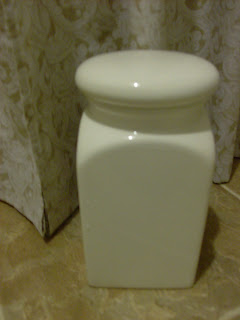INSPIRATION from Country Living Magazine
BEFORE
AFTER
My small house doesn't have a laundry room or a basement so my old, outdated, mismatched but functional washer and dryer are located in my kitchen. Not very attractive but necessary and convenient nevertheless. My favorite quote
"Do what you can with what you have, where you are ." by Theodore Roosevelt certainly applies here.
After my kitchen shelf makeover, I decided to tackle another eyesore in my kitchen, my washer and dryer. I have wanted to fix this problem for some time. I decided the only feasible solution to hide them was fabric. I even bought material a couple of times, but wasn't really in love with the patterns once I got them home.
"The secret of getting ahead is getting started. The secret of getting started is breaking your complex, overwhelming tasks into small manageable tasks, then starting on the first one." Mark Twain Then I read the above quote in a post my daughter Regina wrote on her blog and had my aha moment. I decided that I would commit to working on this project at least 15 minutes a day until it was complete. Of course, once I got started I didn't want to stop.
The first thing I decided to do was to go through my ever-increasing stash of fabrics. Amazingly, I found a neutral colored patterned sheet that I had forgotten about. It had an old, faded look, perfect for a shabby chic kitchen.
Next, I measured the washer and dryer to get the dimensions. For a fuller panel, I also decided to triple the measurement. Doubling the width is usually enough, however, I wanted more volume.
Since my dryer opens in the front, I also decided to cut three individual panels (one for the visible side, one to cover the front of the dryer, and one to cover the front of the washer). I figured this would allow for easier dryer access.
Next, I hemmed all edges of the 3 panels and sewed shirring tape to the top of each panel on the back side, then pulled the strings to the desired width.
Click here for another example with detailed instructions.The example is for a sink skirt, but it follows the same basic steps.
 |
| Image from Ballardstylestudio.com |
After getting the panels to the desired width, I then attached
self stick Velcro strips to the washer and dryer and to the gathered panels over the shirring tape. Be aware that increased fullness may cause the Velcro not to stick on some fabrics and it may have to be glued.
Project Completed
Mission accomplished ! ! ! ! Such a great feeling to complete a long awaited project. I hope this inspires you to tackle something you have been procrastinating about starting.
I




































